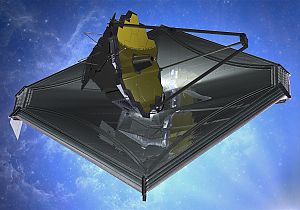Solar shield of James Webb space telescope fully deployed

"All five layers of the solar shield are fully stretched," a NASA employee said at the control centre in the US city of Baltimore on Tuesday, while her colleagues erupted in cheers. The deployment of the shield had begun on Monday. Shaped like a sail, the tennis court-sized sunshield protects the telescope and its sensitive instruments from heat and light. Its hair-thin membranes are made of Kapton, a material known for its resistance to heat and cold.
Complex and risky process
Because the telescope was too big for the Ariane 5 rocket, it had to be folded up before launch. Unfolding it in space was then a complex and risky operation that had caused NASA officials many worries. "If I'm asked what keeps me up at night, it's the deployment of the sun shield," said project manager Bill Ochs before the mission.
An Ariane 5 rocket had launched the successor to the legendary Hubble telescope into space from the Kourou spaceport in French Guyana on Christmas Day. The James Webb Telescope is intended to explore the early days of the universe 13 billion years ago and thus only a few hundred million years after the Big Bang. Astronomers hope to draw conclusions about the formation of the first stars and galaxies.
Development by NASA, ESA and CSA
The telescope, named after a former director of the US space agency, was jointly developed by NASA, the European Space Agency (ESA) and the Canadian Space Agency (CSA). The Max Planck Institute for Astronomy and the University of Cologne also participated. The Viennese space company RUAG Space also contributed to one of the telescope's three main instruments. They supplied two high-precision mechanisms for the "super eye" called "NIRSpec" (Near Infrared Spectrograph). This can detect up to 100 celestial bodies such as galaxies or stars simultaneously. The instrument has a mass of around 200 kilograms and will operate in space at a temperature of minus 238 degrees Celsius. The Viennese company supplied equipment that enables the precise mounting and rotation of a filter wheel and a grating wheel of the "eye".
Red-white-red technology was also used during the final assembly of the telescope on Earth: the device to be able to rotate and tilt the space observatory also came from RUAG Space. The company also supplied the thermal insulation for the telescope's large communications antenna.
Launched in 1989, the space telescope project was originally scheduled to go into operation in the early 2000s. However, new problems delayed the project for years, and the costs tripled to almost ten billion dollars (8.8 billion euros). The launch also had to be postponed several times.
